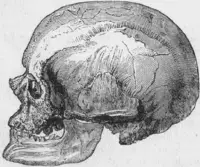Cro-Magnon
The Cro-Magnons (IPA: [kʀomaɲõ] or anglicised IPA: [kɹəʊ'mægnən]) form the earliest known European examples of Homo sapiens sapiens, from ca. 40,000 years ago, chromosomally descending from Y haplogroup F / mt haplogroup N populations of the Middle East.
The term falls outside the usual naming conventions for early humans and is used in a general sense to describe the oldest modern people in Europe.
Excavations
The geologist Louis Lartet discovered the first five skeletons in March 1868 in the Cro-Magnon rock shelter at Les Eyzies, Dordogne, France. The rock shelter contained a large cavity which protected the fossils.
The type specimen from this find is Cro-Magnon 1. The skeletons showed the same high forehead, upright posture and slender (gracile) skeleton as modern humans. Other specimens have since come to light in other parts of Europe and in the Middle East. The European individuals probably descended from an East African origin via South Asia, Central Asia, the Middle East and even North Africa (cromagnoid populations of Mechta El Arbi and Afalou bou Rummel).
The condition and placement of the remains along with pieces of shell and animal tooth in what appears to have been pendants or necklaces raises the question whether or not they were buried intentionally. If Cro-Magnons buried their dead intentionally it shows us they had a knowledge of ritual, by burying their dead with necklaces and tools, or an idea of disease and that the bodies needed to be contained.[1]
Analysis of the pathology of the skeletons shows that the humans of this time period led a physically tough life. In addition to infection, several of the individuals found at the shelter had fused vertebrae in their necks indicating traumatic injury, and the adult female found at the shelter had survived for some time with a skull fracture. As these injuries would be life threatening even today, this shows that Cro-Magnons believed in community support and took care of each others' injuries.[1]
Cro-Magnon lives
Cro-Magnons lived from about 40,000 to 10,000 years ago in the Upper Paleolithic period of the Pleistocene epoch. For all intents and purposes these people were anatomically modern, only differing from their modern day descendants in Europe by their slightly more robust physiology and larger brain capacity than that of modern humans.[citation needed] When they arrived in Europe about 40,000 years ago, they brought with them sculpture, engraving, painting, body ornamentation, music and the painstaking decoration of utilitarian objects. They had a diet of meat, grain, wild carrots, beets, onion, turnip and other foods. All together they had a very balanced diet.
Surviving Cro-Magnon artifacts include huts, cave paintings, carvings and antler-tipped spears. The remains of tools suggest that they knew how to make woven clothing. They had huts, constructed of rocks, clay, bones, branches, and animal hide/fur. These early humans used manganese and iron oxides to paint pictures and may have created the first calendar around 15,000 years ago.[2]
The flint tools found in association with the remains at Cro-Magnon have associations with the Aurignacian culture that Lartet had identified a few years before he found the skeletons.
The Cro-Magnons must have come into contact with the Neanderthals, and are often credited with causing the latter's extinction, although morphologically modern humans seem to have coexisted with Neanderthals for some 60,000 years in the Levant[3] and for more than 10,000 years in France. [4]
Etymology
The rock shelter located at Les Eyzies, Dordogne, France, called Cro-Magnon owes its name to a compound of two elements:
- Cro is presumably a dialectal form of creux, meaning "cavity" or "hollow"; such forms as crau, cro, crouè are found in French dialects, and all probably derive, through Vulgar Latin *crosus (not attested), from a Celtic root.[2]
- Magnon is almost certainly the augmentative form of the Old French adjective magne, from Latin magnus, meaning "large" or "great" and ultimately deriving from the Proto-Indo-European root *meĝh2- (related to English much).
Thus, the probable original meaning is "great cavity".
According to information on display in Les Eyzies-de-Tayac, however, Magnon was simply the name of the proprietor who owned the land on which the cave is located when Lartet made his discovery in 1868.
See also
- Neanderthal interaction with Cro-Magnons
ReferencesISBN links support NWE through referral fees
Sahelanthropus tchadensis • Orrorin tugenensis • Ardipithecus
Australopithecus: A. anamensis • A. afarensis • A. bahrelghazali • A. africanus • A. garhi
Paranthropus: P. aethiopicus • P. boisei • P. robustus
Kenyanthropus platyops
Homo: H. habilis • H. rudolfensis • H. georgicus • H. ergaster • H. erectus (H. e. lantianensis • H. e. palaeojavanicus • H. e. pekinensis • H. e. soloensis) • H. cepranensis • H. antecessor • H. heidelbergensis • H. neanderthalensis • H. rhodesiensis • H. floresiensis • Homo sapiens (H. s. idaltu • H. s. sapiens)
Credits
New World Encyclopedia writers and editors rewrote and completed the Wikipedia article in accordance with New World Encyclopedia standards. This article abides by terms of the Creative Commons CC-by-sa 3.0 License (CC-by-sa), which may be used and disseminated with proper attribution. Credit is due under the terms of this license that can reference both the New World Encyclopedia contributors and the selfless volunteer contributors of the Wikimedia Foundation. To cite this article click here for a list of acceptable citing formats.The history of earlier contributions by wikipedians is accessible to researchers here:
The history of this article since it was imported to New World Encyclopedia:
Note: Some restrictions may apply to use of individual images which are separately licensed.
